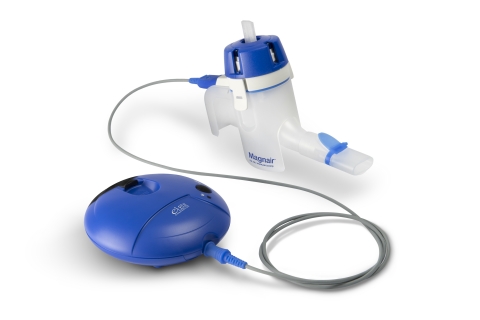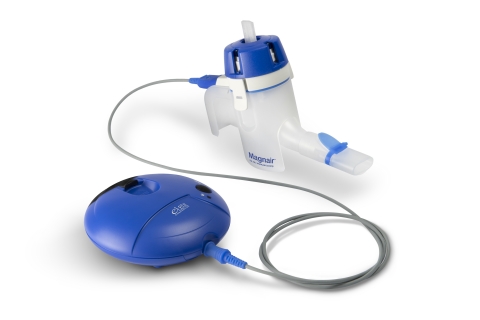MARLBOROUGH, Mass.--(BUSINESS WIRE)--Sunovion Pharmaceuticals Inc. (Sunovion) today announced that the U.S. Food and Drug Administration (FDA) approved the New Drug Application (NDA) for Lonhala™ Magnair™ (glycopyrrolate) Inhalation Solution (25 mcg twice daily), also known as SUN-101/eFlow®, for the long-term, maintenance treatment of airflow obstruction in people with chronic obstructive pulmonary disease (COPD), including chronic bronchitis and/or emphysema. Sunovion expects LONHALA MAGNAIR to be available in U.S. pharmacies in early 2018.
LONHALA MAGNAIR is the first nebulized long-acting muscarinic antagonist (LAMA) approved for the treatment of COPD in the U.S. and the first use of the MAGNAIR, which is based on the closed eFlow® technology system, developed by PARI Pharma GmbH, to treat COPD. This technology is a virtually silent, portable, closed system nebulizer that is designed to deliver the drug in two to three minutes and allows people to breathe normally while using the device.
“We are proud that the FDA has approved LONHALA MAGNAIR as the first nebulized, long-acting muscarinic antagonist treatment option for people in the U.S. living with COPD,” said David Frawley, Executive Vice President and Chief Commercial Officer at Sunovion. “The approval of LONHALA MAGNAIR underscores our leadership in nebulization and the value we place on providing innovative treatment options for people living with COPD. LONHALA MAGNAIR is an important addition to our portfolio of approved COPD therapies for people at various stages of COPD, providing the flexibility to choose handheld or nebulized products based on individual needs.”
“Despite the availability of several therapies, many people still struggle to control their COPD – a challenge that may be affected by the delivery method used to administer a medication,” said Gary Ferguson, M.D., Pulmonary Research Institute of Southeast Michigan, Farmington Hills, Michigan. “LONHALA MAGNAIR offers an important new option that combines the efficacy of a proven medication for COPD with the attributes of a unique handheld nebulizer that allows a person to breathe normally while taking their medication.”
Approximately 15.7 million adults in the U.S. report they have been diagnosed with COPD, a common, preventable and treatable disease that is characterized by persistent respiratory symptoms and airflow limitation that is due to airway and/or lung abnormalities usually caused by significant exposure to toxic particles or gases.1,2 The main risk factor for COPD is tobacco smoking, but other environmental exposures may contribute.2 The disease makes it hard for people to breathe and subsequently may limit their ability to perform some routine activities, including the proper inhalation of medication.2 This improper medication technique may impact treatment over time and may also result in an inadequate amount of the drug reaching the lungs, potentially worsening a person’s COPD.3,4,5 For people with moderate-to-very-severe COPD, nebulized treatments offer an alternative to inhalers, allowing a person to breathe normally while taking their medicine.
The approval is based on data from the clinical trials in the Glycopyrrolate for Obstructive Lung Disease via Electronic Nebulizer (GOLDEN) program, which included GOLDEN-3 and GOLDEN-4, two Phase 3, 12-week, randomized, double-blind, placebo-controlled, parallel-group, multicenter, efficacy and safety trials comparing LONHALA MAGNAIR with placebo in adults with moderate-to-very-severe COPD. At study endpoints, individuals treated with LONHALA MAGNAIR demonstrated statistically significant and clinically important changes from baseline in trough forced expiratory volume in one second (FEV1) at Week 12 versus placebo. An additional study, GOLDEN-5, was a Phase 3, 48-week, randomized, open-label, active-controlled, parallel-group, multicenter safety trial designed to evaluate the long-term safety and tolerability of LONHALA MAGNAIR in adults with moderate-to-very-severe COPD and included the active comparator Spiriva® (tiotropium bromide) delivered by the HandiHaler® device. LONHALA MAGNAIR was generally well-tolerated in clinical studies, with the most common side effects being exacerbations and cough. The overall treatment emergent adverse events (TEAE) incidences were similar for glycopyrrolate and tiotropium groups over 48 weeks.
Anyone seeking medical information, patient assistance and other information about LONHALA MAGNAIR can access Sunovion Answers by calling 1-844-276-8262 Monday through Friday from 8:00 a.m. to 8:00 p.m. ET.
About Lonhala™ Magnair™ (glycopyrrolate) Inhalation Solution
LONHALA MAGNAIR (glycopyrrolate) Inhalation Solution, also known as SUN-101/eFlow®, is the first long-acting muscarinic antagonist (LAMA) bronchodilator delivered via the MAGNAIR, which is based on the closed eFlow® technology system, developed by PARI Pharma GmbH. The MAGNAIR nebulizer is a virtually silent, portable delivery device that reduces the amount of time required to deliver the drug to two to three minutes and allows people to breathe normally while using the device. LONHALA MAGNAIR is approved for the long-term, maintenance treatment of airflow obstruction in people with chronic obstructive pulmonary disease (COPD), including chronic bronchitis and/or emphysema.
Important Safety Information for LONHALA MAGNAIR (glycopyrrolate) Inhalation Solution
INDICATION
LONHALA™ MAGNAIR™ (glycopyrrolate) is a medicine called an anticholinergic. LONHALA MAGNAIR is used long term, twice each day (morning and evening), for maintenance treatment of chronic obstructive pulmonary disease (COPD), including chronic bronchitis and/or emphysema.
IMPORTANT SAFETY INFORMATION
LONHALA MAGNAIR does not relieve sudden symptoms of COPD and should not be used more than twice daily. Always have a short-acting beta2-agonist with you to treat sudden symptoms.
Do not use LONHALA MAGNAIR unless your health care provider has taught you how to use the device and you understand how to use it correctly. Use LONHALA MAGNAIR exactly as your health care provider tells you to use it.
Do not use LONHALA MAGNAIR more often than is prescribed for you. Do not stop using LONHALA MAGNAIR or other medicines to control or treat your COPD unless told to do so by your health care provider because your symptoms might get worse. Your health care provider will change your medicines as needed.
Get emergency medical care if your breathing problems worsen quickly, you need to use your rescue medication more often than usual, or your rescue medication does not work as well to relieve your symptoms.
Do not use LONHALA MAGNAIR if you are allergic to glycopyrrolate or to any of the ingredients in LONHALA MAGNAIR. Ask your health care provider if you are not sure.
Tell your health care provider about all of your health conditions, including if you:
- have kidney problems
- have eye problems such as glaucoma
- have prostate or bladder problems, or problems passing urine
- have any other medical conditions
- are pregnant or plan to become pregnant
- are breastfeeding or plan to breastfeed
- are allergic to LONHALA MAGNAIR or any of its ingredients, or to any other medicines or food products
Tell your health care provider about all the medicines you take, including prescription medicines, over-the-counter medicines, vitamins, and herbal supplements. LONHALA MAGNAIR and certain other medicines may interact with each other. This may cause serious side effects.
Especially tell your health care provider if you take anticholinergics (including umeclidinium, tiotropium, ipratropium, aclidinium, glycopyrrolate).
LONHALA MAGNAIR can cause serious side effects, including:
- sudden shortness of breath (that may be life-threatening) immediately after use of LONHALA MAGNAIR
- serious allergic reactions, including: rash; hives; swelling of the tongue, lips, and face; and difficulty breathing or swallowing. Call your health care provider or get emergency medical care if you get any symptoms of a serious allergic reaction
- new or worsened eye problems, including acute narrow-angle glaucoma (symptoms may include eye pain or discomfort, blurred vision, red eyes, nausea or vomiting, seeing halos or bright colors around lights)
- new or worsened urinary retention (symptoms may include difficulty urinating, urinating frequently, painful urination, urination in a weak stream or drips)
Common side effects of LONHALA MAGNAIR include shortness of breath and urinary tract infection.
These are not all of the possible side effects with LONHALA MAGNAIR. Tell your health care provider about any side effect that bothers you or that does not go away.
LONHALA solution is for oral inhalation only and should not be injected or swallowed. LONHALA vials should only be administered with MAGNAIR.
You are encouraged to report side effects of prescription drugs to the FDA. Visit www.fda.gov/medwatch or call 1-800-FDA-1088.
This information is not comprehensive.
How to get more information:
- Talk to your health care provider
- Visit www.LonhalaMagnair.com to obtain the FDA-approved product labeling
- Call 1-888-394-7377
For additional information, please see full Prescribing Information and Patient Information for LONHALA MAGNAIR at www.LonhalaMagnair.com.
About Long-Acting Muscarinic Antagonists (LAMAs)
A long-acting muscarinic antagonist (LAMA) is a type of long-acting bronchodilator, along with long-acting beta2-agonists (LABAs). According to the GOLD 2017 report, these are currently the first-line standard of care maintenance therapy for symptomatic individuals with COPD, and help the muscles around the airways in lungs stay relaxed to prevent symptoms such as wheezing, coughing, chest tightness and shortness of breath.2,6 LAMAs are widely used and an important therapeutic approach for people with COPD.
About the Phase 3 GOLDEN Clinical Trials
GOLDEN-3 and GOLDEN-4 were pivotal Phase 3, 12-week, randomized, double-blind, placebo-controlled, parallel-group, multicenter, efficacy and safety trials comparing LONHALA MAGNAIR with placebo in adults with moderate-to-very-severe COPD. The GOLDEN-3 trial enrolled 653 people who were at least 40 years old at 45 sites in the United States. The GOLDEN-4 trial enrolled 641 people who were at least 40 years old at 49 sites in the United States. LONHALA MAGNAIR 25 mcg, LONHALA MAGNAIR 50 mcg or placebo was administered twice daily in these studies. The primary endpoint was the change from baseline in trough FEV1 at Week 12. Key secondary endpoints included standardized change from baseline at Week 12 in FEV1 area under the curve (AUC), change from baseline in trough forced vital capacity (FVC) at Week 12, change from baseline in health status measured by St. George’s Respiratory Questionnaire (SGRQ) and change in rescue medication use. Safety was assessed by the number of treatment emergent adverse events (TEAE), serious adverse events (SAE) or major adverse cardiac events (MACE) and the number and percentage of study participants who discontinued due to TEAEs. Both GOLDEN-3 and GOLDEN-4 studies included not only people who were taking effective background long-acting bronchodilator therapy but also individuals with very severe disease and co-existing cardiovascular illness. Approximately 10 percent of the population were elderly (>75 years), 65 percent were classified as being high-risk cardiovascular individuals and approximately 30 percent were taking long-acting bronchodilator therapy [NCT02347761 and NCT02347774].
GOLDEN-5 was a Phase 3, 48-week, randomized, open-label, active-controlled, parallel-group, multicenter safety trial designed to evaluate the long-term safety and tolerability of LONHALA MAGNAIR in adults with moderate-to-very-severe COPD. The study enrolled 1,087 individuals at 111 investigational sites in the United States and Europe. The study evaluated 50 mcg of LONHALA MAGNAIR delivered twice-daily and active comparator 18 mcg of Spiriva® (tiotropium bromide) delivered once-daily by the HandiHaler® device. The primary safety endpoints were: the number and percentage of study participants with TEAEs, the number and percentage of study participants with treatment emergent SAEs, the number and percentage of study participants who discontinued due to TEAEs. Secondary endpoints included the mean change from baseline over 48 weeks in trough FEV1 for all subjects and the number and incidence of subjects with MACE. The study included not only people who were taking effective background long-acting bronchodilator therapy but also individuals with very severe disease and co-existing significant cardiovascular illness. Approximately 10 percent of the population were elderly (>75 years), 65 percent were classified as being high-risk cardiovascular individuals and more than 40 percent were taking long-acting bronchodilator therapy [NCT02276222].
About COPD
Chronic obstructive pulmonary disease (COPD) is a common, preventable and treatable disease that is characterized by persistent respiratory symptoms and airflow limitation that is due to airway and/or lung abnormalities usually caused by significant exposure to toxic particles or gases. The main risk factor for COPD is tobacco smoking, but other environmental exposures may contribute.2 Approximately 15.7 million adults in the U.S. report that they have been diagnosed with COPD.1 It is estimated that several million more adults have undiagnosed COPD.7 COPD is responsible for over 120,000 deaths per year, making it the third leading cause of death in the U.S.1 COPD develops slowly and the symptoms often worsen over time, potentially limiting the ability to perform routine activities.2 Symptoms of COPD include coughing, wheezing, shortness of breath, excess production of mucus in the lungs, the inability to breathe deeply and the feeling of being unable to breathe.6 The symptoms of COPD can be most severe during the night and early morning.8 Morning symptoms can be associated with limitation of activities during the day, impaired health status and increased risk of exacerbation.9 Night-time symptoms disturb sleep, reduce sleep quality and, in the long term, may be associated with development or worsening of cardiovascular diseases, cognition, depression and increased mortality.10
About Sunovion Pharmaceuticals Inc. (Sunovion)
Sunovion is a global biopharmaceutical company focused on the innovative application of science and medicine to help people with serious medical conditions. Sunovion’s vision is to lead the way to a healthier world. The company’s spirit of innovation is driven by the conviction that scientific excellence paired with meaningful advocacy and relevant education can improve lives. With patients at the center of everything it does, Sunovion has charted new paths to life-transforming treatments that reflect ongoing investments in research and development and an unwavering commitment to support people with psychiatric, neurological and respiratory conditions. Sunovion’s track record of discovery, development and/or commercialization of important therapies has included Lonhala™ Magnair™ (glycopyrrolate) Inhalation Solution, Utibron™ Neohaler® (indacaterol/glycopyrrolate) Inhalation Powder, Seebri™ Neohaler® (glycopyrrolate) Inhalation Powder, Arcapta Neohaler (indacaterol) Inhalation Powder, Brovana® (arformoterol tartrate) Inhalation Solution, Latuda® (lurasidone HCI) and Aptiom® (eslicarbazepine acetate).
Headquartered in Marlborough, Mass., Sunovion is an indirect, wholly-owned subsidiary of Sumitomo Dainippon Pharma Co., Ltd. Sunovion Pharmaceuticals Europe Ltd., based in London, England, and Sunovion Pharmaceuticals Canada Inc., based in Mississauga, Ontario, are wholly-owned direct subsidiaries of Sunovion Pharmaceuticals Inc. Additional information can be found on the company’s websites: www.sunovion.com, www.sunovion.eu and www.sunovion.ca. Connect with Sunovion on Twitter, LinkedIn, Facebook and YouTube.
About Sumitomo Dainippon Pharma Co., Ltd.
Sumitomo Dainippon Pharma is among the top-ten listed pharmaceutical companies in Japan operating globally in major pharmaceutical markets, including Japan, the United States, China and the European Union. Sumitomo Dainippon Pharma aims to create innovative pharmaceutical products in the Psychiatry & Neurology area and the Oncology area, which have been designated as the focus therapeutic areas. Sumitomo Dainippon Pharma is based on the merger in 2005 between Dainippon Pharmaceutical Co., Ltd., and Sumitomo Pharmaceuticals Co., Ltd. Today, Sumitomo Dainippon Pharma has about 6,500 employees worldwide. Additional information about Sumitomo Dainippon Pharma is available through its corporate website at www.ds-pharma.com.
LATUDA and SUNOVION are registered trademarks of Sumitomo Dainippon
Pharma Co., Ltd.
BROVANA is a registered trademark of Sunovion
Pharmaceuticals Inc.
APTIOM is a registered trademark of BIAL, used
under license.
SEEBRI and UTIBRON are trademarks of Novartis AG,
used under license.
ARCAPTA and NEOHALER are registered trademarks
of Novartis AG, used under license.
LONHALA is a trademark of
Sunovion Pharmaceuticals Inc.
MAGNAIR is a trademark of PARI Pharma
GmbH, used under license.
eFlow and eLete are
registered trademarks of PARI Pharma GmbH.
Spiriva and Handihaler
are registered trademarks of Boehringer Ingelheim Pharma GMBH & Co KG.
Sunovion Pharmaceuticals Inc. is a U.S. subsidiary of Sumitomo Dainippon
Pharma Co., Ltd.
© 2017 Sunovion Pharmaceuticals Inc.
All rights reserved.
For a copy of this release, visit Sunovion’s web site at www.sunovion.com
References
1 MMWR: Morbidity and Mortality Weekly
Report. Employment and Activity Limitations Among Adults with Chronic
Obstructive Pulmonary Disease — United States, 2013. March 27, 2015;
64(11). Available at http://www.cdc.gov/mmwr/.
2
GOLD Guidelines 2017. http://www.goldcopd.org/guidelines-global-strategy-for-diagnosis-management.html.
Accessed: March 16, 2017.
3 Singh S, Loke YK. An
overview of the benefits and drawbacks of inhaled corticosteroids in
chronic obstructive pulmonary disease. International Journal of
Chronic Obstructive Pulmonary Disease. 2010;5:189-195.
4
Restrepo RD, Alvarez MT, Wittnebel LD, et al. Medication adherence
issues in patients treated for COPD. International Journal of Chronic
Obstructive Pulmonary Disease. 2008;3(3):371-384.
5
Taffet GE, Donohue JF, Altman PR. Considerations for managing chronic
obstructive pulmonary disease in the elderly. Clinical Interventions
in Aging. 2014;9:23-30. doi:10.2147/CIA.S52999.
6
National Heart, Lung and Blood Institute. (2013). “What Are the Signs
and Symptoms of COPD?” Retrieved from https://www.nhlbi.nih.gov/health/health-topics/topics/copd/signs.
7
National Heart, Lung, and Blood Institute. “What is COPD?” Available at: http://www.nhlbi.nih.gov/health/educational/copd/what-is-copd/index.htm.
Accessed: March 2, 2016.
8 Partridge MR, Karlsson N,
Small IR. Patient insight into the impact of chronic obstructive
pulmonary disease in the morning: an internet survey. Curr Med Res Opin.
2009;25:2043–8.
9 Roche N, Small M, Broomfield S,
Higgins V, Pollard R. Real world COPD: association of morning symptoms
with clinical and patient reported outcomes. COPD. 2013;10:679–86.
10
Agusti A, Hedner J, Marin JM, Barbé F, Cazzola M, Rennard S. Night-time
symptoms: a forgotten dimension of COPD. Eur Respir Rev. 2011;20:183–94.





